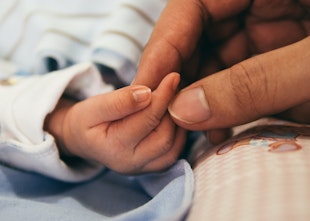If you still look pregnant months after giving birth, you may have a diastasis recti. Diastasis Recti is when the rectus abdominis muscles in your abdomen separate during pregnancy, leaving a gap that allows your belly to stick out.
If you still look pregnant months after giving birth, you may have a diastasis recti. Diastasis Recti is when the rectus abdominis muscles in your abdomen separate during pregnancy, leaving a gap that allows your belly to stick out.
Here's how it happens
Your rectus abdominis (the "six-pack muscles") is a pair of long, flat muscles that run vertically down each side of your abdomen. These muscles hold in your internal organs and stabilize your core.
As your belly expands during pregnancy, the connective tissue gets stretched out, allowing the rectus abdominis to pull apart and separate vertically down the middle. (Pregnancy hormones also play a role by relaxing the connective tissue to accommodate your growing baby.)
Sometimes the tissue heals, and the muscles come back together after delivery when your hormone levels return to pre-pregnancy levels. But if this doesn't happen in three to six months, you can end up with a gap that won't close without treatment. Studies show that about 40 per cent of women have a diastasis at six months post pregnancy.
After pregnancy, a diastasis recti looks like a ridge or even a loaf of bread protruding from your midline. The ridge becomes more prominent when you're straining – from coughing or sitting up, for example. It may disappear or cave in when you lie down or relax your abdominal muscles.
Do I have a diastasis recti?
To check for a diastasis recti, lie on your back, with your knees bent and your feet on the floor. Place your hand palm down over your belly, with your fingers pointing toward your toes. Press your fingers gently into your navel area then slowly lift your head, drawing your chin to your chest. This causes your rectus abdominis to contract.
If you feel a gap of at least two finger widths between the muscles as they contract, you have a diastasis. A gap as wide as four or five fingers is considered severe.
What can I do about a diastasis recti?
Once the connective tissue gets stretched out, it can be difficult to rebuild your core strength and bring your muscles back together. Doing traditional crunches can actually make your condition worse. They tend to make those muscles tighter, pushing them further apart and stretching the connective tissue even more so that it grows thinner and weaker.
If your diastasis is severe, and you don't plan to get pregnant again, surgery may be an option, especially if you've done all you can with physical therapy but are still struggling with a weak core.
Surgery to repair a diastasis recti involves stitching the abdominal wall muscles back together along the midline. In some cases, a surgeon may be able to do the procedure laparoscopically (using a tiny camera and instruments inserted through small incisions). Severe diastases require open abdominal surgery through a larger incision.
If you do plan to have more children, it's worth the effort to repair a diastasis with physical therapy (not surgery) to strengthen your core before your next pregnancy. It may recur, but it's likely to be less severe.
Can diastasis be avoided?
If you can, it's a good idea to begin doing exercises to strengthen your core before you become pregnant. Once you're pregnant, you can continue some of them through the first trimester. But even gentle core strengthening is largely ineffective once your belly gets big.
In any case, it's likely that staying active can help. Studies show that women who exercised regularly during pregnancy were less likely to end up with a diastasis recti.
Is it ever too late to correct a diastasis?
No. With proper care, you can close a diastasis even years after you delivered your last baby. How long it takes to heal depends on the severity of your diastasis (the distance between the separated abdominal muscles and the damage to the stretched connective tissue) as well as your commitment to fixing the problem.
Written by Laura Doyle staff writer at FFHQ who also blogs at www.lovelifeandlittleones.com.






